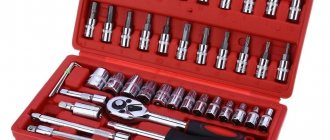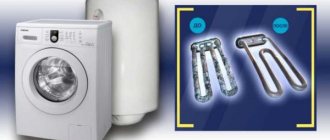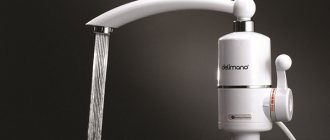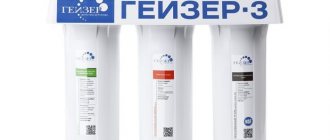The water heater does not heat in the event of a malfunction of the elements
The water heater stops heating the water, in most cases due to the fact that some elements are faulty. The most common cause of breakdown is due to:
Namely because of the tubular heater, which breaks down with prolonged use without maintenance and general wear.
Anode
A rod that is made of a non-corrosive type of steel, on the surface of which there is a magnesium coating. This device attracts salts, which is why the heating element does not fail for a long time.
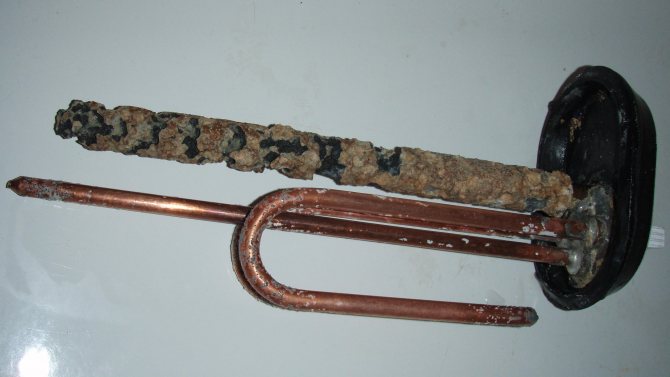
Note! When the anode breaks due to wear, the water heater may stop heating the water for the reason that corrosion forms. The metal bar should be replaced annually.
Thermostat
A component that controls the heating of a liquid to a certain degree. Its task is to determine the temperature of the water and compare with the one that was set by the user, as well as turn on or off the relay.
Insulation gaskets
Sealing elements of the drive and flange connector, the main task of which is to protect the owner from electric shock.
The main components of the iron and the tasks they perform
Main components
- Electrical wire that connects to the terminal block.
- A thermostat that controls the temperature.
- A heating element.
- Perforated sole with steam holes.
- Water supply system, which includes a boiler, supply buttons, pipes, nozzle, etc.
The principle of operation of the device
- The hidden heating element heats up the metal sole of the iron when the device is plugged in.
- The degree of heating is regulated by means of a bimetallic plate. As the temperature rises, it deforms and opens the contacts. The heating intensity is determined by the thermostat.
- When you press the supply button, the water poured into the boiler is discharged by drops to the sole, comes into contact with the heated surface there and forms steam.
Some models of well-known manufacturers are equipped with an automatic shutdown card, an intelligent control system, a descaling cartridge built into the boiler and other components.
Causes of malfunction
Often, the boiler does not heat the water and the light does not light up due to scale deposits, faulty thermal protection, interruption of the liquid supply as a result of a breakdown of the safety valve. The boiler often breaks down due to limestone, a malfunction of the electronic module or setting the equipment to maximum power.
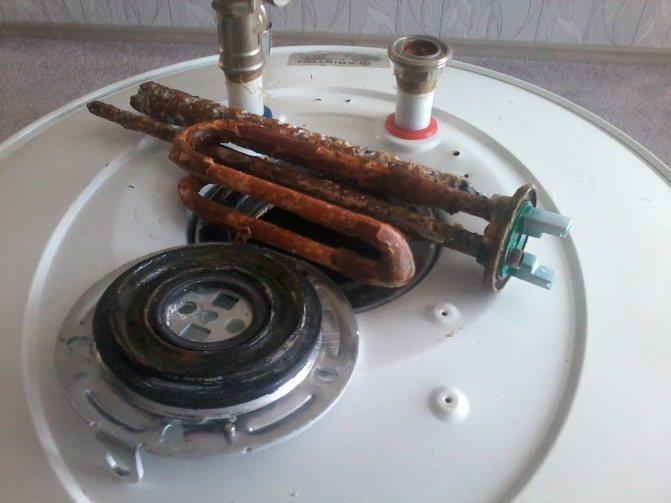

Note! To establish the exact reason why the water heater does not heat up, a thorough visual examination of the device is necessary. It is best to entrust this to professional craftsmen.
Poor water quality
In response to the question why the water heater does not heat the water to the required temperature, it can be pointed out that boilers most often break down due to the fact that the water contains heavy metals, hydrogen sulfide and other chemical components.
Damage to electrical wiring
Equipment may be malfunctioning due to damaged electrical wiring. Before starting, make sure that all wires and cables are intact.
Errors during installation
It is important to trust the boiler installation only to professional craftsmen. Otherwise, there is a risk of damaging the ceramic surface of the boiler or installing it incorrectly.
Incorrect use of the device
Often, the water in the water heater does not heat up due to the installation of a higher power, non-compliance with the technical manual for the device.Therefore, before turning on the device, you must read the instructions.
Control module malfunctions
The reason for the lack of water heating in the washing machine may be malfunctions of the electronic control system. Microcracks may appear in the electronic module, more precisely on its board, which will break the contacts. Also, the firmware may "fly off", for example, as a result of a power surge. All this leads to malfunctions of the module, which may also be the reason that the washing machine stops heating the water. In certain cases, the control module must be repaired, and sometimes a complete replacement is required.


A breakdown of a washing machine, like all household appliances, can occur at any time. Various preventive measures will help to delay the time of an unpleasant surprise from the side of technology. They will help to increase the service life of the clipper and protect it from other possible malfunctions. Indeed, in addition to the considered situation, when the washing machine does not heat the water, this is far from the only reason why washing cannot be done. Preventive measures include fairly simple rules.
- It is not necessary to load the machine "to the eyeballs".
- Treat your device with care.
- Try to use quality detergents for washing.
- Use water filters and clean / replace them regularly.
- Use descaling agents and detergents to clean your washing machine.
Fulfillment of these rules will not take much time and effort, but it can significantly increase the term without problematic operation of the machine.
Malfunction symptoms
A faulty water heater will make unpleasant sounds during operation or not turn on at all.


Often, when a leak from the cables speaks of a malfunction of the equipment, the appearance of error codes on the dashboard.
Panel light is on
In the absence of water heating by a water heater, but the presence of the indicator lamps, there is a breakdown of the heating element. To check that the heating element is not working properly, you must use a multimeter to adjust the resistance determination and connect to the heating device. Zero can light up and appear on the indicator due to a short circuit and a break in the system.
Note! Another evidence that the heating element does not work is that the automatics are triggered, which turns off the device immediately after it turns on. This indicates the combustion of the tubular electric heater.
The determination of such a malfunction is easy. The thermal protection button sinks in when the device is turned off. If the heater turns on after that, it is necessary to descale or replace a new heating element.
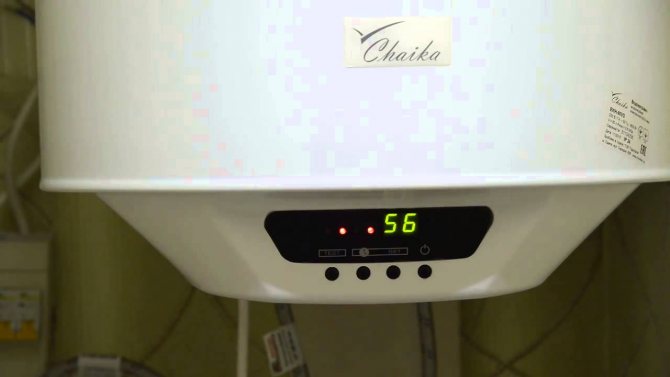

Lime deposits are formed on the heating element due to the fact that the anode is faulty - the magnesium rod, which is responsible for the destruction and prevention of scale formation.
Panel light is off
If the light on the dashboard does not light up, you need to take a tester or multimeter and see if there is a voltage supply to the thermostat. For this, the tester is connected to the boiler. If there is voltage, then it is necessary to try to restart the system. If the device shows zero phase or surges, then the thermostat must be replaced.
The boiler does not warm up to the maximum
Often, many people meet with the fact that the boiler does not heat the water up to the maximum volume and the lamp does not light up. In this case, it may be:
- the heating element is faulty or not operational;
- The heating element has deposits in the form of scale;
- the safety valve is faulty;
- the electronic board does not work.
In case of suspicion of one of the above malfunctions, it is necessary to remove the water from the water heater and disassemble it. Then check all the elements with a multimeter, a tester and a voltage indicator.
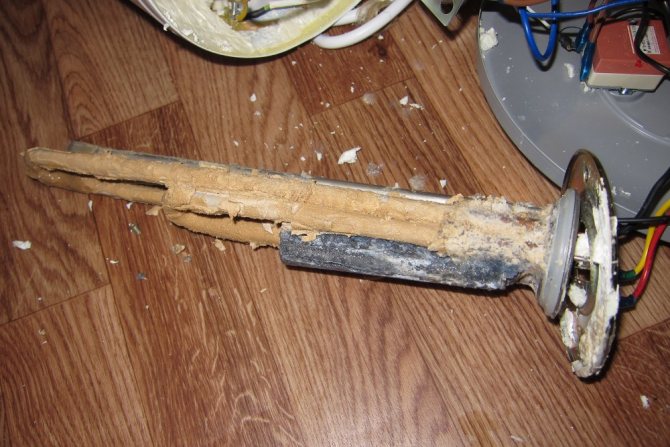

Most often, the reason for the lack of maximum heating of the boiler is in the heating element. This problem is relevant for older boilers. In them, the service life of heating elements is limited. They work no more than 4 years. When there is prolonged operation on the heating element, a thick layer of deposits appears in the heating element, which reduces the heat output. The element may be closed with a break. The item may also be burned. Then there will be a need to purchase and install a new heating element. Often the reason is improper installation and operation of the boiler installation.
Ways to solve problems
It is necessary to solve the problem with a non-working boiler, depending on the reasons that led to the equipment breakdown.
Replacing the heating element
Replacing the heating element should be carried out by a competent and experienced craftsman or by the user himself, in accordance with the instructions given to the equipment. It is worth noting that despite the fact that all boilers are different in appearance and design features, the heating element is replaced in the same way.
To work, you need to take:
- pliers;
- indicator screwdriver, flat and Phillips;
- wrench in a set.
Note! Regardless of what led to the need to replace the heating element, it is necessary to perform the following steps step by step:


- Turn off the boiler and turn off the water;
- Put the hot water tap in the closed position;
- Drain all liquid from the heating element;
- Remove the cover with an indicator screwdriver and make sure that there are no voltage terminals;
- Place the boiler on the floor, unscrew the nuts and disconnect the wires. It is better to photograph the process of disconnecting all parts in order to insert all the wires back in the same order.
- Replace the heating element and put everything in place, acting in the reverse order, making sure that no water gets on the contacts.
It is worth noting that, along with the replacement of the tank, it is often required to change the magnesium anode, gaskets and insulation, if it has dents with breaks.
Heating element cleaning
To clean the heating element covered with scale, it is necessary to take citric acid and maintain it in a water-citric solution for several days. Remove limescale residues with dirt with a stiff brush.
Replacing the thermostat
If it is necessary to replace the thermostat, first remove the retaining ring, remove the thermostatic sensors, remove the control block, install a new thermostat with the retaining ring and assemble the water heater.
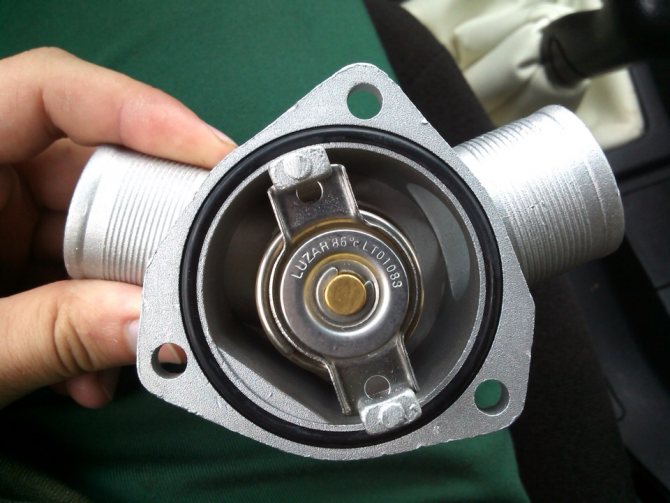

Note! Immediately after the thermostat is changed, the water heater cannot be used. It is necessary to look for leaks in the connections, open the hot water tap and drain the accumulated air. Only then can a test run be carried out with a gradual increase in the heating temperature.
Fork heats up
If the plug heats up slightly during operation of the boiler, the matter may be in the power of the heating device. However, with strong heating, it may be a poor-quality extension cord or tee. To maintain safe operation, it is necessary to use an extension cord with a large cross-section of wires.
Sometimes it might be about the outlet. With prolonged and repeated use, the socket with the plug loosens. This causes the temperature of the plug to rise. It is recommended to continuously check that the socket is firmly seated in the socket. If the plug falls out of the socket, the appliance must be replaced.
If only the plug heats up and the cable adjacent to it heats up slightly, then the problem may be that the contact of the internal wires is poor. In the plug, troubleshooting is simple by tightening the terminals. If it is non-separable, it is necessary to replace such a plug.
Note! The cord heats up due to insufficient wire cross-section in the extension cord, breakdown in the heating element or heater connections. Often times, this can cause the wire to catch fire.To prevent fire and explosion, reliable insulation of the wiring and replacement of defective heating elements is necessary.
No steam, no splashing water
If the iron has been in use for a long time, the owner may be faced with a situation where the iron stops steaming. At the same time, it regularly turns on and maintains the temperature in accordance with the selected mode.
There are two probable causes of malfunctions:
- blockage;
- failure of the anti-drip system.
If hard water is poured into the iron, after several months of operation, deposits in the tubes, nozzles, and holes of the sole can accumulate in such an amount that they block the steam outlet.
To remove the blockage, you need to descale the iron according to the instructions. A clogged nozzle can be mechanically cleaned with a sharp needle. If necessary, you can use the following descaling products:
- Citric acid, soda or vinegar, poured into the inside of the tank in certain proportions.
- Chemicals: MAGIC POWER, Topperr, Top House, etc.
Perforated holes in the sole can be finished with ammonia or a special pencil.
If cleaning does not help, the problem may lie in the anti-drip system. In some models, a special thermal disc is installed, which bends when the heating element starts to heat. He lifts the plate, pressing the valve, which shuts off the water supply. If the system malfunctions (the disc is deformed, the plate comes off when it falls, etc.), the valve can shut off the hot water supply. To correct the malfunction, it is necessary to straighten the misaligned parts and fix them in the desired position.
Self repair
If during the diagnostics it turned out that the current goes to the boiler installation, it is necessary to disconnect the device from the network and find the thermal safety button on the thermostat, drowning it until it clicks. If after that, the boiler began to work well by itself, after a while it is necessary to remove the formed scale and see how the water heater works from the inside, it is possible to replace the magnesium anode.
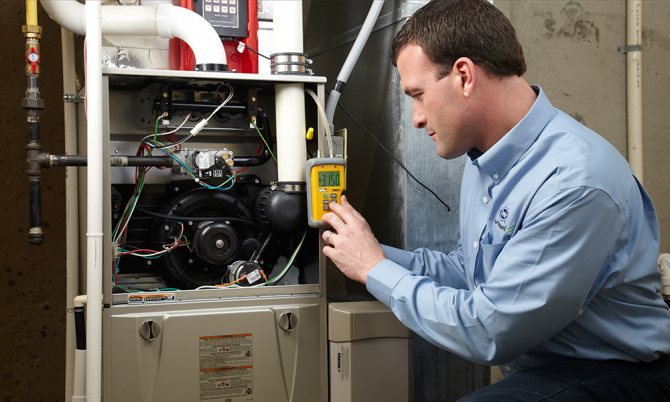

As for the thermostat malfunction, it is easy to replace it yourself. As for the repair, it cannot be done in many water heaters, since electronic-type thermostats are used in domestic and foreign boilers. Repair is available in Ariston and Tee-Tech water heaters.
Recommendations
Many users recommend that, in the absence of water heating by a boiler, immediately contact a service center or call a master at home to correctly diagnose and fix the breakdown.
In the event of a faulty heating coil, users are advised to replace the element rather than trying to fix the problem by winding nichrome wire. It is necessary to understand what is the specificity of flow-through devices. During manufacture, the spiral is coated with ceramics at the factory to prevent scale build-up. Some models have a non-removable heating element and in order to dismantle it, it is necessary to break open the copper sheath, and then solder or weld it.
Note! If the water pressure is too low, users say that the water flow sensor does not give a signal to the heating coil and this breakdown is most often found in Atmora and Termeks. In this case, you need competent help from an electrician.
If the radiator is clogged, you must first check its condition, then rinse the element with a descaling agent. If there is a severe blockage, the radiator should be soaked for a while. Some users advise doing this for up to 10 hours.
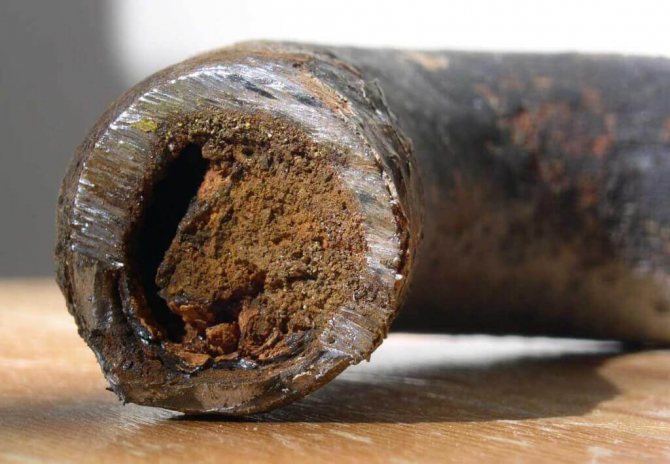

In general, a water heater of any type and production does not heat water for various reasons. Most often this happens due to damage to the heating element, the formation of scale and improper operation of the equipment. In some cases, it is recommended to contact professionals.Basically, all breakdowns can be repaired by yourself.
Damaged electrical wiring, faulty heating element can lead to improper operation of the boiler. To find out why it does not function, you need to carefully examine it. The heating element does not work for the following reasons: a lot of scale has accumulated on its surface, the thermal protection button does not turn on; the heater may not heat up the water due to a faulty safety valve. It is necessary to find out all the reasons why the water heater does not heat the water, but the indicator is on or off.
What to do if the cooler stops heating the water after the first start
You bought a cooler and delivered it home, but there are no water bottles yet. You can't wait to turn on your brand new machine and check if its indicators are on. This is one of the most common mistakes made by users of water spill equipment that has not been in operation for a long time. Usually, after such actions, you have to call the service center with a complaint that the cooler does not heat the water. If you are reading these lines, then, having avoided this error, you can save at least 1 thousand rubles on repairing the burnt out thermal protection of the dispenser.


Most often, the thermal protection of coolers is triggered due to users' carelessness or if they did not bother to familiarize themselves with the operating instructions of the device.
Important!
The dispenser can be connected to the power supply only after you have made sure that all its accumulators (heating and cooling) are filled with water to the required level. Otherwise, the thermal protection will operate, which protects the heating elements from burnout. To turn on the triggered thermal protection, you need a long screwdriver.
However, before repairing, make sure that the heating key on the back of the appliance is on. It happens that consumers, forgetting to turn on this toggle switch, contact the service center with a complaint that the cooler does not heat the water. If the key is on, and the heating system of the device does not work, you need to proceed to further actions. Beforehand, the cooler must be disconnected from the electrical outlet.
The container in which the water is heated is located in the back of the cooler case. This tank for compressor models is visible through the compressor grill. If your model has an electronic cooling system, the decorative cover must be removed to see the heating tank.
The heating accumulator has the form of a cylinder in a casing made of thermal insulating material. On its body there are 2 two-contact groups. A thermal fuse is located between the contacts of one of the groups (most often the one at the top). It looks like a small black button or a microswitch, which you need to lightly press with a screwdriver. Then you need to make sure that the cooler tanks are filled with water. To do this, open both taps of the dispenser and wait until water flows out of them in an even stream. Then we connect the cooler to the power supply and set the heating toggle switch on the rear panel to the on position.
Common causes of breakage
Often the reason for the malfunctioning of the heating element can be a non-working electronic module. Do not try to repair it yourself. A breakdown of the unit can be caused by the actuation of the emergency fairings. Due to scale deposits on the heating element, the fairings start to turn on in random order.
You can check the operation of the water heater using an incandescent lamp. It must be connected to a heating element. After connection, the electrical circuit must be connected to a power source. The heating element is functioning correctly if the lamp is on. Another way is to use a multimeter.On it, you need to turn on the resistance measurement mode, connect it to the heating element. When the circuit is closed, the indicator will show zero. If the chain is open, the indicator will be infinity.
The water heater does not heat the water, but the lamp does not light up
There are situations in which the heater does not heat the water to the required temperature, the lamp does not burn. The reasons for the breakdown may be:
- idle heating element;
- a lot of scale deposits have appeared on the heating element;
- the safety valve does not work;
- the electronic board does not work.
IMPORTANT! ThTo solve these problems, you need to drain the water, disassemble the boiler. Check the correct operation on it with a multimeter, voltage indicator, tester. If the indicators indicate incorrect operation of its elements, replace them or eliminate the causes of their breakdown.
The boiler does not heat, but the lamp is on
The causes of this problem are various breakdowns.
The handle is in the "minimum" mode, for this reason the tank does not warm up to the required temperature. This problem can be solved by turning the knob in the clockwise direction of the hand. The thermostat came on. To get out of this situation, turning on the thermal protection button will help. It is located in different places on different models. The valve is not closed. You need to put your palm to the riser. If it is warm to the touch, and cold water comes out of the tap, then the valve is not working. It needs to be closed or bought and replaced with a new one. Heats up for a long time. Do not drain the water right away, it will be right to wait until it heats up.
Options for solving the problem of malfunction of the heating element
Cleaning with one liter of water, 50 grams of citric acid. The apparatus is immersed in a solution prepared from these substances for two days. After that, it is pulled out and the scale is removed. Replacing the heating element on different models of boilers is the same. To produce it you need:
- shut off valve;
- clean the heater;
- for safety reasons, you need to de-energize the boiler;
- remove the protective cover;
- with a special screwdriver find out if there is voltage;
- take a photo of the connection diagram;
- remove the heating element from the mounts (if necessary, put a rag);
- wait until the attachment point is completely dry (contacts should not have moisture);
- look at the anode, find out if it is working properly;
- check the rubber gasket for wear;
- after the heating element has been replaced, install all the parts back.
Having done all these steps, you need to make sure that there are no leaks. The air in the boiler must be released, and then the unit must be plugged in.
Why the water heater does not heat the water to the maximum
One of the common reasons why the boiler does not function correctly is the faulty operation of the heating element. This problem is typical of ancient models. Typically, the life of the heating element is four years. Over time, deposits form on it. They interfere with the normal operation of the device.
If you do not take any measures to replace it, clean it, this can lead to failure of the heating element. The heater may not work properly due to a breakdown of the thermostat and therefore do not heat hot water.
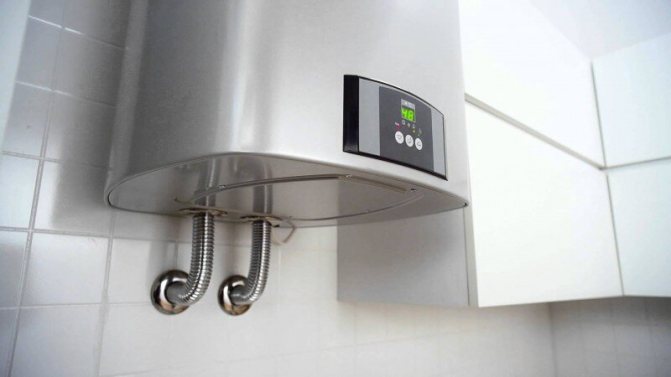

Electric water heaters fail just as often as other household appliances. This is due to poor water quality, damage to electrical wiring, failure of the heating element, error during installation or improper use of equipment. Typical problems can be corrected by yourself, without the involvement of specialists.
The lack of hot water negatively affects the usual way of life. If the water heater does not heat the water, while a light is on on it, you should worry about its early restoration.
If the listed elements do not work properly (or if they fail), electric water heaters will not perform their main functions:
- Heating element - often fails due to prolonged use.
- Anode - rod made of non-corroding steel with a magnesium surface coating. It attracts all the salts in the water. With active use of the water heater it is recommended to replace the anode at least once a year.
- Thermostat - an internal element that controls water heating. In automatic mode, the element compares the current temperature with the one set by the user and turns on / off the heating relay.
- Insulation gaskets - gaskets between the connecting elements of the pipes and the water heater.
Why does an electric water heater do not heat water well?
You should not immediately call the master if the boiler does not heat up enough water. Anyone can fix this problem. The following guidelines will come in handy. First of all, you need to check all the main parts of the boiler for serviceability. After that, it will become clear whether it is possible to fix the malfunction yourself:
- Most likely, the heating element of the water heater stopped working. Experts recommend replacing the heating element every four years.
- This breakdown is indicated by the activation of automatic protection when the water heater is turned on. That is, it automatically turns off immediately after being turned on.
There are several more ways to check the health of the heating element. With their help, you can finally make sure that this element requires replacement.
The first method is more difficult to execute and requires minimal electrical knowledge. You need to take a test lamp and connect it to the heating element. Then this electrical circuit is connected to the power source. The heating element works normally if the light is on.
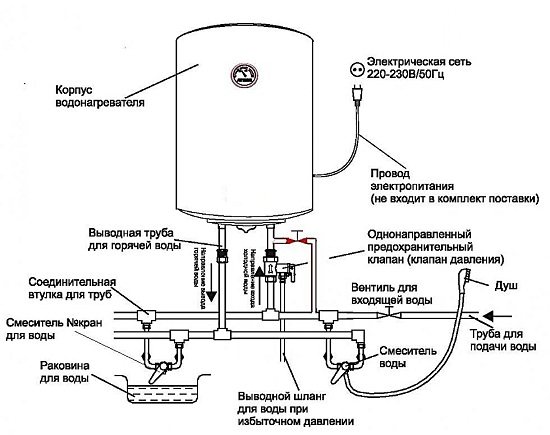

The same check can be done with a multimeter. To do this, you need to configure it to measure resistance and connect it to the heating element. The indicator will be at zero when closed, and in case of an open circuit, it will display infinity.
Determine the cause of the malfunction
Typical causes of malfunctioning instantaneous water heaters and boilers include:
- poor water quality;
- error during installation of the device;
- damage to electrical wiring;
- improper operation.
The failure of the heating element is associated with the appearance of scale accumulating on the surface of the tank or due to a malfunction of the thermal protection button and safety valve.
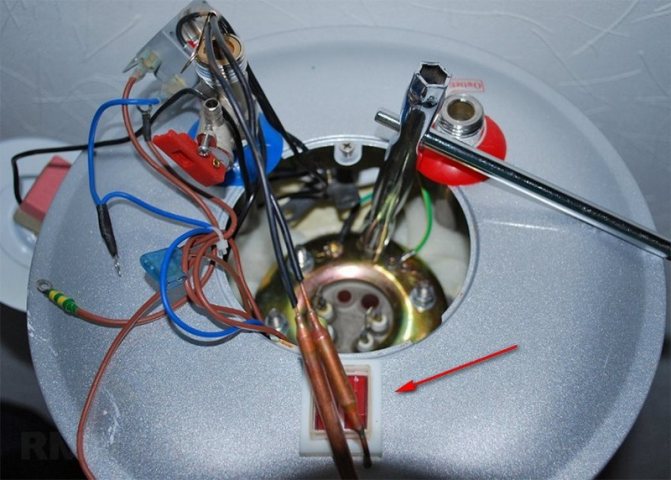

Another common reason why the water heater does not heat the water is a faulty electronic module of the device. It is strictly forbidden to replace it yourself., especially if the equipment is under warranty service. Contact our master for qualified help.
A careful visual inspection of the boiler is required to determine the cause of the malfunction. Be sure to pay attention to the light bulb, which lights up when the device is in operation (when heating). If it is off, try increasing the heating temperature. There may be 2 situations:
- The lamp came on (or indicator).
If the water heater does not heat the water, but the indicator lamps on the panel are on, this indicates a failure and the need to replace the heating element. A multimeter will help make sure of this., which is connected to the device and is adjusted to a certain resistance indicator. If you see zero on the indicator, the problem is in the circuit. You see the symbol of infinity - there is an electricity cut in the circuit.
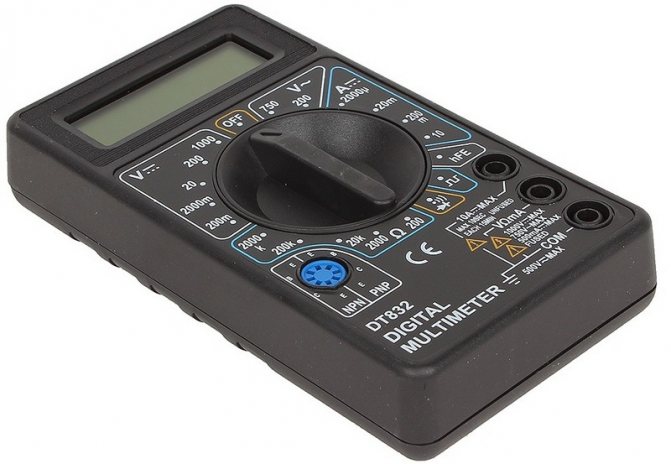

It may also happen that when the device is turned on, the automation immediately turns it off. This is another indicator of failure of the tubular electric heater.... Use a little trick to check! Lock the thermal protection button with your finger and turn on the water heater. If it starts to work, then you can return it to its full state by descaling. Do not forget to check the condition of the anode.
Criteria determining the choice of instantaneous water heater
It is imperative that before buying an electric instantaneous water heater, you need to know what pressure is in the water supply system, in addition, you should inquire about the parameters of the electrical network to which you plan to connect - the device does not tolerate sudden changes and low voltage, interruptions in operation. It is necessary to study the possibility of laying a separate cable.


But before that, you should determine:
- what power the device is capable of meeting the demand for water heating, while the initial water temperature should be taken into account;
- if there is a need to connect several points, and there is absolutely no desire to purchase two devices and perform installation twice, it is better to choose a pressure flow pipe. But at the same time, a sufficiently high pressure must be provided in the water supply.
Of course, the price of the product can also affect the choice of model. First of all, the models of well-known and trusted manufacturers of this type of product deserve preference. In addition, it is imperative to pay attention to the availability of additional options, which are often not only a nominal function, but also greatly facilitate operation. For example, the presence of a power control system allows you to get water heated to the required temperature at the outlet, but at the same time helps to save energy.
The boiler does not heat up the water, the lamp is on
When the indicator light is on and there is no water heating, the problem is solved in 2 ways:
- Perhaps the temperature control knob is set to a minimum and the water in the tank simply cannot warm up to the desired temperature. In this case, simply increase the minimum heating level (by turning the knob clockwise).
- The thermostat may have turned on. In this case, simply turn on the thermal protection button. Please note that on water heaters Thermex, Baxi, Ariston and others the button can be located in different places of the case.
The water heater does not heat, the lamp does not light up
Another typical situation is that the boiler does not heat the water up to the required temperature, while the indication lamp does not light up. This indicates the following problems:
- the presence of scale on the heating element;
- malfunction of the control board (electronic component);
- heating element malfunctions;
- failure of the safety valve.


To verify this, water is completely drained from the tank, the device is disassembled. All internal electronic components must be checked using a multimeter, tester and voltage indicator. If these devices are not at home or you do not know how to use them, call the wizard.
Why the water in the boiler is not heated - the main reasons
Like any electrical equipment, water heaters periodically fail for various reasons. As a rule, most minor breakdowns can be repaired by yourself, for example, changing the safety valve. You should not repair boilers with a volume of 80 liters or more on your own. Such devices have a large tank and will weigh a lot even without water. Flow models are small in size. You need to get help. To repair the boiler without losses, it is necessary to correctly determine the reason why the water heater does not heat the water.


Inspection of the device
The water heater does not heat due to a breakdown:
- Heating element. The most common reason for a non-working boiler is a burned out heating element. This part refuses to work for tubular water heaters due to old age.
- Anode - magnesium rod Not many people know, but this part must be changed at least once every 12 months. If the water heater does not heat well, then most likely the replacement of the rod is required. With daily operation, the equipment may need to be replaced twice a year.The anode collects plaque, which can spoil the inner surface - which is why the boiler will not heat the water.
- Thermostat is a water heater element responsible for temperature control. The device measures the temperature of the water. If the temperature matches the program set by the user, the relay is automatically disconnected. When the water cools down to a temperature below the required one, the device will automatically turn on and start heating.


Boiler thermostat
- Insulating gaskets. These parts are used between the reservoir and the flange to seal the connection area. In addition, gaskets are a mandatory element, their failure can cause an electric shock.
The boiler does not heat the water well
Poor heating of water in the boiler in 90% of cases is caused by the state of the heating element. The service life of this element is no more than 4 years. Over time, scale appears on its surface, which reduces heat transfer. Sometimes an open or short circuit occurs. This can only be determined with a multimeter. In this case, be sure to pay attention to the condition of the thermostat.!
The average boiler heating time is 2 to 4 hours, depending on the volume of the tank. If it heats up to half the set temperature, then there are functional problems with the equipment.
Troubleshooting
Replacement of heating elements
Replacement of heating elements for water heaters Ariston, Electrolux, Termeks and others is similar, despite the design differences and the different appearance of the devices. In work you will need:
- wrenches (with caps);
- pliers;
- plus and minus screwdrivers;
- screwdriver with voltage indicator.
The sequence of actions is as follows:
- Close the water in the riser, drain the inside from the boiler.
- Disconnect the power to the appliance from the mains.
- Remove the decorative cover that gives access to the electronic components and check the absence of voltage with an indicator screwdriver.
- Remove the terminals and disconnect the wires (in this case, be sure to remember the diagram of their connection). It will not be superfluous to photograph the connection diagram.
Do not allow moisture to get on the terminals, contacts and the electronic board of the device to avoid short circuit and damage.
- After removing the cover and disconnecting the wires, take out the heating element.
- Check its condition, clean the anode from deposits.
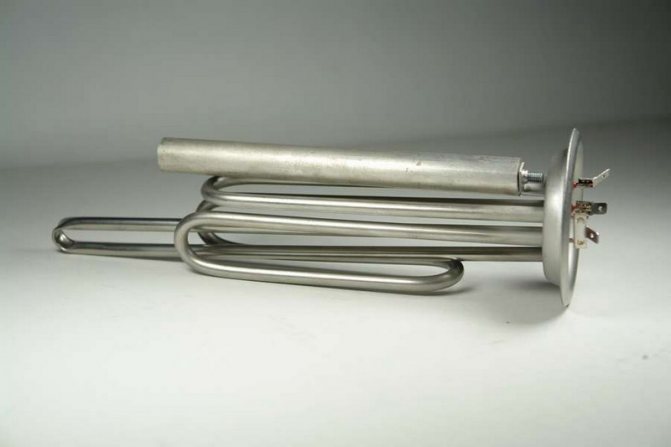

The installation of a new element is carried out in the reverse order, while remember the rules of your own safety in order to avoid electric shock.
How to carry out the repair process
- First of all, you will need to turn off the water, if there is no tap at the boiler, turn off its supply at the riser. In this case, it is very important that the hot water outlet valve is closed.
- Then you need to drain the water, the water heater must be completely empty.
- Now disconnect the water heater from the mains, this is a prerequisite that will ensure your safety.
- Using a screwdriver, remove the protective cover.
- At this stage, you will need a screwdriver with an indicator, use it to check if there is no voltage at the water terminals.
- Some models require at this stage to remove the water heater from the mounts on which it is held. Disconnect the wires, but first you should remember the diagram so that you do not make mistakes when connecting. The most convenient way is to simply take a picture with a camera or phone.
- The heating element fixes the nuts, it is recommended to unscrew them one at a time, since during this process residual water may pour out and here you will need a pre-prepared material that absorbs water well.
- Wait until it is completely dry before installing a new element. To keep all contacts dry.
- Pay attention to the anode, it is possible that this part is out of order. Its purpose is to protect the heating element itself and the tank from corrosion.
- Also inspect the rubber gasket, it may also be damaged and needs to be replaced. With its help, tightness is ensured.
- After replacing the heating element, reassemble, carefully following all the recommendations only in the opposite direction.
Do not immediately connect the device, first you need to check the cold water supply and the absence of leaks.
Then you need to open the hot water tap and release all the air. Only after that the connection to the network is made and the operation of the water heater is checked.
It is possible and necessary to repair the boiler yourself, since repair work is not so cheap. The most important thing is to have all the necessary tools in stock, and, only having prepared them, start work.
A water heater is not a very complex device, but do not forget to use the instructions for use when making repairs.
Perhaps your water heater stopped working for some simple reason, and to fix it, you just need to press a button or switch a lever. But, most likely, if it does not heat the water or does not heat it well, cleaning or replacing the heating element is required.
Replacing the thermostat
Proceed as follows to replace the thermostat:
- Remove the retaining ring (pressure) near the heating element.
- Remove the sensor adjustment unit and the thermostat itself.
- Install a new item.
- Secure it with a pressure ring.
- Check the condition (position) of the safety valve.


Please note that it is not recommended to start using the device immediately after replacing the thermostat! Check the correct flow of cold water inside, check if the connecting piece hiss. Then a hot tap is opened in order to release the air that has accumulated inside the boiler. Only then can a test run be carried out..
The plug heats up when the water heater is running
Fork heating (slight) - allowed during operation. But if it gets too hot, you need:
- Visually check the condition of the tees and extension cords to which the device is connected. Try to choose an extension cord with a large wire size for fire safety purposes.
- Check the condition of the outlet so that the water heater plug is firmly seated in the sockets. In some cases, when the plug or socket is loose, the adjacent part of the wire may become warm.


An incorrectly selected extension cord can cause a fire in a house or apartment, since water heaters are powerful and energy-intensive devices (1.2-2.6 kW).
Flow type water heater does not heat water
By the number of instantaneous water heaters, suppliers sell an order of magnitude less than storage electric ones. This is due to increased power consumption. Typical reasons why instantaneous water heaters do not heat water:
- Faulty coil... Optimal is to replace the element. Winding nichrome thread will help solve the problem for just a few days. This increases the fire hazard.
Weak water pressure... The water sensor through the electronic unit does not send a signal for heating to the spiral. A common instrument problem.
Clogged radiator... Disconnect the device from the mains and disassemble it. If the radiator is heavily clogged, place it in a lemon solution for several hours.
If you plan to leave the water heater off for a long time (for example, during a long absence from home), try to completely drain the water from the tank and hoses. This will eliminate the likelihood of limescale and deposits on the surface, and will also increase the service life of the device. When turned on, self-diagnostic devices will help to check the status and readiness for operation (show error codes E2, E3 or all indicators flash).
Why does the instantaneous water heater not heat the water?
Instantaneous water heaters are smaller than storage water heaters, so they need more electricity. They heat up more water and consume up to 15 kilowatts. According to statistics, this type of heater is more dangerous, which means that their repair requires more attention.
There are several reasons why the instantaneous water heater does not heat the water:
- Heating coil defective. This problem cannot be eliminated by simply winding nichrome wire. It's dangerous to do that. Better to replace the heating element. It is worth considering the features of instantaneous water heaters. At the factory, the spiral is specially coated with ceramics to prevent the formation of scale. Not all models of heaters are equipped with a removable heating element. The non-removable heating element can only be removed after opening the copper sheath. After repair, the casing is welded or sealed.
- With a low water pressure, the instantaneous water heater does not heat the water. This is because the water flow sensor does not signal the heating coil. All water heaters of this type have this feature.
- A clogged heater radiator can cause poor water heating. To check its condition, you need to de-energize the device and disassemble it into parts. It is best to rinse the radiator with a descaler. If the radiator has not been cleaned for a long time, it will need to be soaked for several hours.
To prevent blockages, it is better to filter the water before entering the water heater. And if the device will not work for a long time, it is better to completely drain the water from it.

